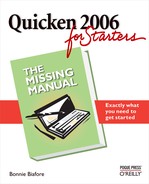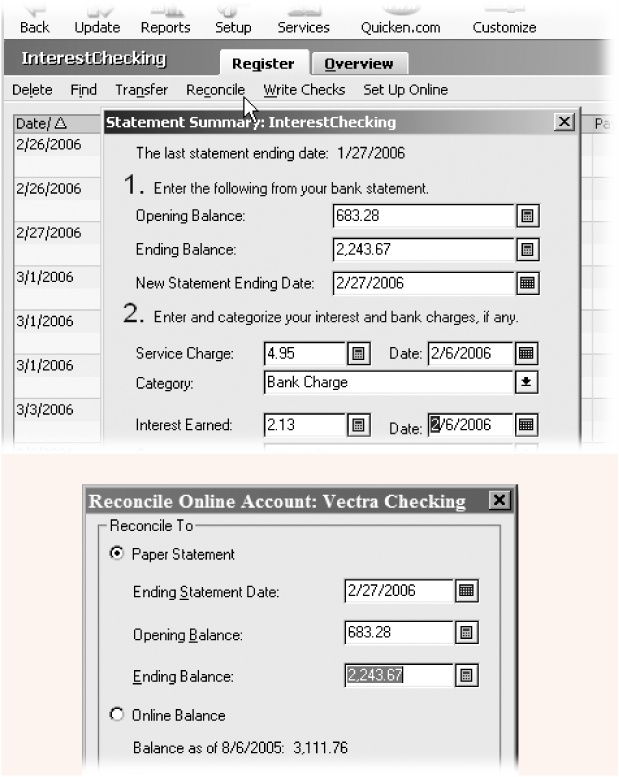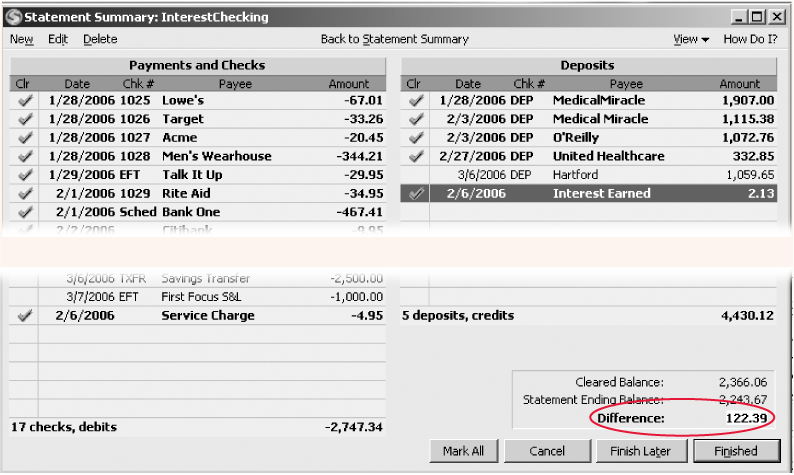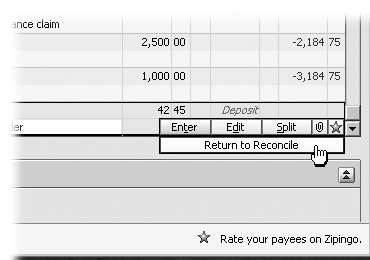Chapter 7. Reconciling Accounts
Admit it: Your least favorite part of having a checking account is the monthly struggle to get your handwritten register to agree with the bank’s balance. No matter how careful you are to record every check, debit card withdrawal, and ATM fee, the numbers never seem to match. Tracking down the error is an exercise in frustration—did the bank make an error? Or do you have to redo your math yet again?
Every step of the way, Quicken takes the agony out of reconciliation. First of all, it does the math for you, error-free. If you download transactions from the Web, you may even be able to reconcile with a single click, since your register and the bank’s will always agree on which checks have cleared. And if you do transpose numbers or forget to record an ATM withdrawal, Quicken has tools to help you isolate the problem.
With reconciliation being so easy, there’s no excuse for not doing it. Never again will you bounce a check because you thought you had more funds available. Furthermore, when you reconcile regularly, you’re more likely to catch transactions that you didn’t make—and catch some con artist using your finances for his fun.
Your First Reconciliation
The first reconciliation for a bank account is always the hardest, because your opening account balance in Quicken rarely equals the opening balance on your bank statement. (These two balances typically match only when you open an account after you start using Quicken, when the balances are both zero.) Even if you started out in Quicken by copying the bank’s opening balance from a statement, the first reconciliation might uncover stray transactions from earlier periods.
So the first time you reconcile your account, a small discrepancy between your Quicken balance and the bank’s doesn’t necessarily mean there’s an error on either side. You may simply want to dispense with that discrepancy, and then things will be much clearer next month. Fortunately, Quicken can generate a transaction that adjusts your account’s opening balance to match the balance on your bank statement, as described in the box on Section 7.4.
Preparing for a Reconciliation
Part of Quicken’s charm is that it doesn’t care if you create, edit, or delete transactions right in the middle of reconciliation. But that’s not necessarily the easiest way to go about it. If your Quicken register is up to date, you can reconcile your account in mere seconds. If you want to experience that pure, unadulterated pleasure, take a moment before you reconcile to make sure that you’ve entered all the transactions in your account:
Checks. Check numbers missing from your check book and in Quicken are a big hint that you wrote a paper check and didn’t record it in your Quicken data file. Create any missing check transactions.
Charges. If you have credit card charges scattered across your desk, gather them up and make sure you’ve recorded them all in the Quicken credit card account.
Transfers. Don’t forget to record transfers and ATM withdrawals.
Deposits. If you’re like most people, you don’t forget to deposit checks you receive. Make sure you’ve recorded those deposits in Quicken as well.
Online transactions. For accounts set up to use online banking, download transactions before you reconcile your account. (This step is so useful that Quicken reminds you to do so as soon as you begin reconciliation.)
Tip
If several months have gone by since you last reconciled your account, don’t try to make up time by reconciling multiple months at once. You’ll just find it harder to spot discrepancies and trace problems to their source. Put your bank statements in chronological order and then walk through the reconciliation process for each statement. With Quicken, each one takes only a few minutes.
Starting to Reconcile
Reconciling an account has two simple, distinct steps. The first is to choose the account you want to reconcile and give Quicken some basic statistics about the account: the ending balance from your bank statement, and any service charges and interest earned during the statement period. This section describes how to kick off account reconciliation.
In the Account Bar, choose the account that you want to reconcile. (You can also press Ctrl+A to open the Account List window, select the account, and choose Go To in the window menu bar.) In the register menu bar, choose Reconcile.
Tip
If the account is set up for online access, you may see a dialog box at this point warning you that your downloaded transactions don’t appear up to date. Click Yes to cancel the reconciliation and download transactions. When your account is up to date, choose Reconcile once more.
Depending on whether the account is set up for online access, Quicken opens one of two dialog boxes, both shown in Figure 7-1.
The Statement Summary dialog box (top) appears for accounts that don’t use online services. You fill in the text boxes for bank charges and interest with the values from your paper statement.
The Reconcile Online Account dialog box (bottom) opens for accounts set up with online access. You don’t have to enter bank charges and interest, because you download those with your other transactions. You can download transactions but still choose to reconcile to your paper statement.
Think twice before you choose the Online Balance option, though. If you turn it on, Quicken reconciles your account to your bank’s records every time you download transactions. If you later want to reconcile against a paper statement, you’re in for some manual tweaking of transaction reconcile status—a feat that’s best left to Quicken experts. (Online balances and paper statement balances rarely match, because your online balance shows the up-to-the-minute status of cleared checks, whereas a paper statement is a snapshot taken at the statement date.)
Here’s how to fill in the text boxes for reconciliation summary information:
Opening Balance. The program uses the ending balance from the previous reconciliation to fill in the Opening Balance for this reconciliation. If the Opening Balance doesn’t match the beginning balance on your bank statement, click Cancel, and go to Section 7.7 to learn how to correct the problem.
The first time you reconcile an account in Quicken, you must enter the Opening Balance from your previous statement.
Ending Balance. Enter the ending balance from your paper statement.
New Statement Ending Date. Quicken fills in a date one month after the previous reconciliation. If necessary, change this date to match the ending statement date on your paper statement. (For online access accounts, you’ll just see the Ending Statement Date, as described in the box on Section 7.4.)
Service Charge. Enter the monthly service charge for this statement. In the Date box, choose the date on which the service charge was levied. In the Account box, choose the account to which you want to post the charge (usually Bank Charge). Quicken uses this information to create a service charge transaction for you.
After your first reconciliation, Quicken fills in the date and category for service charges and interest earned. You have to enter these values only if you’ve changed categories or Quicken’s date is significantly different.
Interest Earned. If your account pays interest, regardless of how petty, in the Interest Earned box, enter the interest you earned from the bank statement. As you did for service charges, specify the date and the account that you use to track interest you earn.
Note
If you use online banking, chances are you’ve already downloaded your service charge and interest transactions. That’s why the Reconcile Online Account dialog box doesn’t include text boxes for these items.
After you’ve entered this information, click OK to proceed to the second part of reconciliation, described in the next section.
Reconciling Transactions
When you click OK in either the Statement Summary or Reconcile Online Accounts dialog boxes, Quicken opens a grand version of the Statement Summary window listing the money that flows out of your account in the Payments and Checks column and money flowing in under the Deposits column. As Figure 7-2 illustrates, your assignment is to mark every transaction that your bank has cleared and, when the Difference value is zero, click Finished to complete the reconciliation.
If you download transactions from your financial institution and match them to the transactions in Quicken, there’s not much for you to do besides click Finished. The bank isn’t likely to disagree with itself, and you’ve already cleared most transactions during your downloads. But if you record transactions in Quicken yourself, you must mark the cleared transactions in Quicken to reconcile them to the paper statement.
The Statement Summary window groups payments and charges on the left side with deposits and other credits on the right side. Match each transaction on your statement to a transaction recorded in Quicken, and then add a checkmark in the Clr column to let Quicken know it’s cleared. Check it off on the paper statement, too, so you’ll know you’ve done it. If you get to the end and the Difference hasn’t yet reached zero, an unchecked transaction in either place is often the culprit. (If you can’t track down the problem and are desperate to stop searching for that unaccounted-for $1.50, see the box on Section 7.5.)
Clicking in the Clr column toggles the checkmarks on and off. If you download transactions from your bank, Quicken automatically marks them as cleared, so you usually don’t have to turn on any transaction checkmarks when you reconcile. What you might have to do, especially if you record transactions manually in the register, is turn off the checkmarks for transactions that you recorded in the wrong account, as duplicates, or mismatches. After you turn off a checkmark, in the window menu bar, choose Delete to remove the transaction from the register.
When you click Finished, Quicken displays the Reconciliation Complete dialog box with a hearty congratulation to make you feel good about your accomplishment. The dialog box asks if you want to create a reconciliation report. If you use Quicken only for personal finances and generally breeze through reconciling without problems, click No, the most popular choice by far. On the other hand, for a record of the results of the account reconciliation, whether for the paper trail that accountants and bookkeepers need or to resolve potential problems in the future, click Yes.
Note
If you reconcile a credit card account, Quicken pops up a Make Credit Card Payment dialog box so you can make a payment on your credit card balance. Better yet, pay it off and eliminate those interest charges and fees.
Even if you reconcile your statements month after month without a hitch, that doesn’t necessarily mean your accounts are error-free. For example, you may notice that there are a few transactions from four months ago languishing uncleared. When you review these transactions, you’ll probably find a charge you made on a different credit card, a duplicate that you forgot to delete, or some other minor problem. Every so often, the answer is that the check didn’t make it to the vendor or your deposit never made it to the bank, so it’s worthwhile to occasionally research these old and uncleared transactions.
Modifying Transactions During Reconciliation
Even if your Quicken register is rife with errors and omissions, getting through reconciliation is surprisingly painless. Quicken immediately updates the Statement Summary window with changes you make in the account register window, so you can jump to the register window and make your changes. When you return to the Statement Summary window, the changes are there—ready to be marked as cleared.
Here’s how you make changes while reconciling:
Adding transactions. If a transaction appears on your bank statement but isn’t in Quicken, in the Statement Summary menu bar, choose New. The program jumps to a blank transaction in the account’s register window.
Tip
In the Statement Summary window, double-clicking any transaction takes you to that transaction in the register. But once you’re in the register, you can record as many forgotten transactions as you want. To get back to the Statement Summary window, underneath the active transaction, click the Return to Reconcile button.
Deleting transactions. If you find a duplicate transaction, select it. In the Statement Summary menu bar, choose Delete. You have to click Yes to confirm your decision before the program deletes the transaction.
Editing transactions. If you notice an error in a transaction, select it and choose Edit in the Statement Summary menu bar. Quicken jumps to the transaction in the account register. Correct the mistake, record the transaction by clicking Enter, and then click Return to Reconcile.
When you work in the register window during reconciliation, you’ll see an extra button—Return to Reconcile, as illustrated in Figure 7-3. After you add, edit, and delete the transactions, you can click Return to Reconcile to jump back to the Statement Summary window or, at the bottom of the Quicken main window, click Reconcile.
Stopping and Restarting a Reconciliation
The Statement Summary window includes a Finish Later button for saving your reconciliation work without completing it. But the only time you’re likely to click this button is when you’ve run into a discrepancy that requires some research. For instance, you’re relaxing on Sunday by reconciling your checking account, and notice a questionable bank charge. You can click Finish Later and return to your reconciliation after you’ve talked to your bank on Monday morning.
In the Statement Summary window, click Finish Later. Quicken closes the window, but it remembers what you’ve cleared. You’ll see a lower-case “c” in the Clr column for each transaction that you’ve marked, which indicates that the transaction is only tentatively cleared.
When you’re armed with fresh information and a strong dose of caffeine, choose Reconcile in the register menu bar. The Statement Summary or Reconcile Online Account dialog box opens, containing the summary values you typed in on your first attempt. If they’re still correct, click OK to open the Statement Summary window for another try.
When Your Records Don’t Agree with Your Bank’s
When you attempt to modify a transaction that you’ve already reconciled, Quicken would do well to set off flashing lights and sirens warning you of the havoc you’re about to wreak. After all, the transaction appeared on your bank statement because it was a done deal, and changing it in Quicken doesn’t change it in the real world. Nevertheless, Quicken instead lets you change or delete reconciled transactions with nothing more than a mild message box asking if you’re sure you know what you’re doing.
But make no mistake: Making changes to reconciled transactions is the quickest way to create mayhem in your accounts. For example, in the register window, deleting a reconciled transaction removes its amount from the Opening Balance when you try to reconcile the account. And that means that the Opening Balance won’t match the beginning balance on your paper bank statement (which is one reason you might be reading this section).
Sometimes, subtle errors, missing transactions, or an errant click of an uncleared check can foul your attempts to reconcile an account. Here are some techniques to help bring your records back into balance:
Look for transactions cleared or uncleared by mistake. Go through your bank statement again, checking off each transaction you’ve marked in Quicken. Make sure that every transaction on the bank statement is marked in the Statement Summary window. If you check off each transaction on your paper statement when you mark it in Quicken, simply look for the telltale missing checkmark on your paper statement. Check that no additional transactions are marked. If you want to start over, unmark all of the transactions and begin checking them one by one.
Look for duplicate transactions. If you both create transactions in Quicken and download transactions, duplicate transactions are often to blame. Scan the register for multiple transactions with the same date, payee, and amount.
Here’s a trick for ferreting out duplicate transactions: Count the number of transactions on your bank statement, and then compare that number to the number of cleared transactions displayed at the bottom of the Statement Summary window (illustrated in Figure 7-2, back on Section 7.4). Unfortunately, this transaction count won’t help if you enter transactions in Quicken differently than they appear on your bank statement. For example, if you deposit every payment individually, but your bank shows one deposit for every business day, your transaction counts won’t match.
Look for a transaction equal to the amount of the difference. This approach helps you find a single transaction that you marked or unmarked by mistake, or a duplicate transaction that you marked as cleared.
Look for a transaction equal to half the difference. This technique helps you find transactions that you recorded the wrong way around. For example, if a $500 check becomes a $500 deposit by mistake, your reconciliation will be off by $1,000 ($500 because a check is missing and another $500 because you have an extra deposit).
Check transactions for transposed numbers. It’s easy to type $95.40 when you meant $94.50. Before you examine every transaction amount for these hard-to-spot errors, divide the Difference value by 9. If the result is a whole number of dollars or cents, such as 5 dollars or 10 cents, chances are you’ve transposed numbers. For example, say you have a difference of .90, or 90 cents. Dividing by 9 results in .1—that is, 10 cents. If the result is something like 1.52 or .523 (52.3 cents), transposed numbers are not to blame. That this works is one of those facts you must simply accept, like the fact that you can’t lick your elbow.




